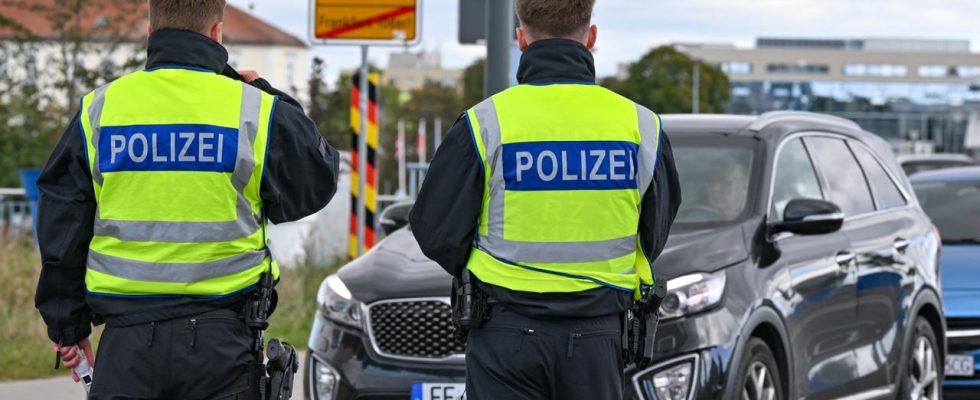The federal police have started border controls at the crossings with Poland and the Czech Republic. Which highways are affected? And what is the traffic situation like? The overview.
Immediately after Federal Interior Minister Nancy Faeser (SPD) gave in, the federal police increased their presence at the German borders in the east. Saxony, Brandenburg and Mecklenburg-Western Pomerania reported more intensive controls on roads, directly at border crossings and in rail traffic – and Bavaria also started the measure.
Brandenburg
In Brandenburg, which borders Poland, checks started in several places, as a spokeswoman for the Berlin Federal Police Directorate confirmed to the dpa news agency. Federal police officers checked directly at the border on the city bridge in Frankfurt (Oder). It can be assumed that the focus will now be on fixed controls at all border crossings, it said.
The federal police have so far assessed the traffic disruptions caused by the new border controls on the German-Polish border as manageable. So far there have been no backlogs at the border, said a federal police spokesman. The traffic situation is largely normal.
The federal police control immigration traffic at the German-Polish border crossing Stadtbrücke between Frankfurt (Oder) and Slubice
Bavaria
The federal police also began stationary border controls on the border between Bavaria and the Czech Republic. The measures have been running since Monday, as a spokesman for the Munich Federal Police Directorate said. The authority initially did not provide any more precise information about control locations or times. Work in the border area with the Czech Republic will also continue in close coordination with the Bavarian Border Police, which is part of the state police.
The federal police are increasing controls to the Czech Republic at the Schirnding border crossing
Mecklenburg-Western Pomerania
In Mecklenburg-Western Pomerania there have been “stationary, continuous controls” at the Pomellen border crossing on the A11 motorway from Poland since Monday afternoon. This was said by a spokesman for the Bad Bramstedt Federal Police Directorate. In addition, there are also “flexible controls” on other transport routes from Poland to Mecklenburg-Western Pomerania with different time windows and locations at the border line. “We are there with strong forces,” said the spokesman.
Just last weekend, the federal police in Mecklenburg-Western Pomerania picked up several groups of illegally smuggled migrants. A total of 37 immigrants were caught on the German-Polish border between Penkun and the island of Usedom, it was said. The vast majority of refugees came from Syria, some from Iran, Algeria, Yemen and Iraq.
Saxony
There are also controls in Saxony, which borders on Poland and the Czech Republic, said a spokesman for the Pirna Federal Police Directorate. The motorway 17 (Prague – Dresden) was affected, among others. In addition to the flexible border controls throughout Saxony’s border area with Poland and the Czech Republic, according to the police, travelers also have to be prepared for more intensive controls on the A4 and A17, on the branch lines and in cross-border rail traffic from Prague to Dresden.
Federal police officers check a truck in Saxony near the German-Czech border
For Saxon Interior Minister Armin Schuster (CDU), border controls are the only way to determine “who is currently coming into our country”. Dem mdr He said that there had been no alternative to border controls for a long time. “But at least since the attacks on October 7th in Israel. We have been in a worsening security situation for months, with extremely high migration pressure at the same time,” said Schuster.
The domestic policy spokeswoman for the Saxon Left, Kerstin Köditz, criticized the short message service X that the decision only benefited the AfD.
Internal border controls continued to Austria
According to the responsible authorities, the border controls were carried out in close consultation with the police authorities of the respective federal states as well as the border protection and customs authorities of neighboring countries. For “tactical reasons”, the Federal Police Headquarters in Potsdam does not provide any information on the number of forces deployed or on the type and scope of the control measures, it said.
The authority simply announced that with the Federal Ministry of the Interior’s decision to initiate temporary internal border controls, the Federal Police had “initiated control measures in the immediate vicinity of the border or directly at the border” along the borders with Poland, the Czech Republic and Switzerland. The internal border controls already underway with Austria would be continued.
Faeser’s decision
In view of the significantly increased number of refugees, Federal Interior Minister Faeser notified the EU Commission of stationary border controls with Poland, the Czech Republic and Switzerland. In the future, the federal police will be able to “flexibly deploy the entire package of stationary and mobile border police measures depending on the current situation,” she said. Faeser had long rejected permanent stationary controls that had long been demanded by the Union and, among other things, pointed out the effects on commuters and freight transport.
Since the refugee crisis of 2015/2016, stationary controls in Germany have only been carried out at the borders with Austria. According to the Federal Ministry of the Interior, they will now be extended again together with the notification of the controls for Poland, the Czech Republic and Switzerland. According to the EU Commission, the controls in Austria will initially continue to apply until May 11th next year.
From the beginning of January to the end of September, 233,744 people in Germany applied for asylum for the first time, around 73 percent more than in the same period last year. Many municipalities see themselves at the limit when it comes to accommodation, care and integration of refugees – also because more than a million war refugees from Ukraine have come to Germany since the Russian war of aggression began in February 2022. They do not have to apply for asylum.

